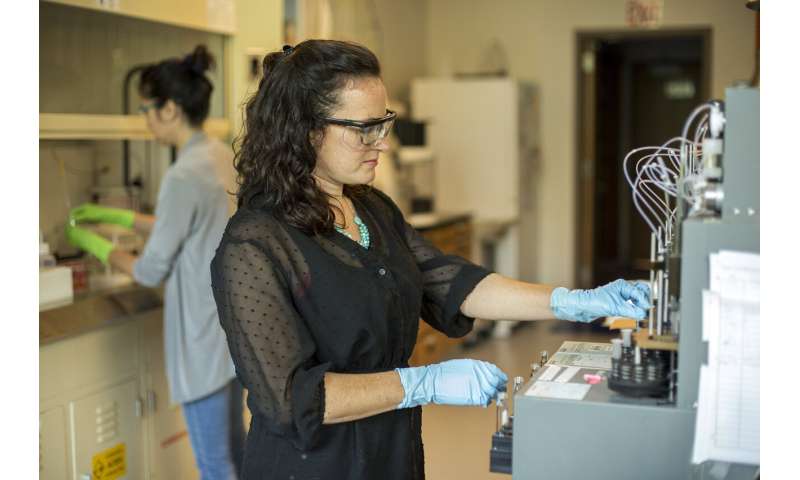
Detergents, shampoos, soaps and other everyday items sometimes contain a group of chemicals called phthalates, which are often used to enhance products and add flexibility to plastics. However, mounting research has shown a link between phthalates and effects on hormones in humans, laboratory animals and wildlife, which is why phthalates are increasingly being replaced with other chemicals, such as a compound called DINCH.
In collaboration with the Medical University of South Carolina, researchers at the National Institute of Standards and Technology (NIST) analyzed urine samples from pregnant women to look for the presence of DINCH, which is short for di(isononyl)cyclohexane-1,2-dicarboxylate. They found concentrations of DINCH in most of the urine samples but no evidence of effects in lab assays on two hormones, progesterone and estrogen. The researchers have published their findings in the journal Chemosphere.
Phthalates are often called plasticizers and can be found not only in personal care products to help them maintain a gel-like consistency but also in garden hoses, inflatable toys and medical tubing. “They are used to provide flexibility in plastics. Think of a rubber ducky and how squishy it is. That’s because of phthalates in vinyl,” said NIST researcher John Kucklick.
However, phthalates can disrupt the hormonal or endocrine system, which may cause pregnancy loss, infertility and harmful effects on the delivery of a baby.
As a result, many manufacturers have replaced phthalates with chemicals such as DINCH, another type of plasticizer, but less is known about the effects of this chemical compound on humans. DINCH has been used since 2002 in commercial products such as toys, medical devices and food packaging.
“People are exposed to different compounds, and we find out about some of them, such as phthalates, which are being replaced by industry,” said NIST researcher Jessica Reiner. “We may or may not know a lot of information about these new compounds, but studies like this one are always looking to understand if they’re a good substitute compared with other ones.”
Once DINCH enters the human body, it is processed and broken down into compounds called metabolites and excreted in the urine. The researchers collected urine samples over a period of four years from a total of 100 pregnant women living in the Charleston, South Carolina, area who planned to deliver at the Medical University of South Carolina medical center. The samples were then analyzed to check for DINCH metabolites.
Plasticizers are found everywhere, and it is challenging to measure the compound by itself because of all the possible contamination sources in the lab. “So, we look at the metabolites that have gone through a person, and they’re only found in urine and not found anywhere else. It’s much easier to measure than the unmetabolized compound,” said Kucklick.
At the Hollings Marine Laboratory in Charleston, NIST researchers analyzed urine samples for three DINCH metabolites using liquid chromatography (a technique that separates a sample into its individual parts) and tandem mass spectroscopy (which measures the mass-to-charge ratio of ions). Results showed that one type of DINCH metabolite, OH-MINCH, was detected in 98% of the urine samples. But the concentration levels of the metabolite were low and 275 times less than the most prevalent phthalate metabolite, monoethyl phthalate, suggesting that levels of human exposure to DINCH are smaller. But researchers weren’t just looking at concentration levels of DINCH.
Another aspect of the study was to analyze DINCH exposure by race. Of the 100 pregnant women, half were African American, while the others were Caucasian. Concentrations of OH-MINCH were 50% higher in African American women compared to Caucasian women, which was consistent with a 2017 study that looked at phthalate levels, led by Abby Wenzel, a NIST postdoctoral researcher at the time.
Researchers hypothesized the difference in concentration levels could be attributed to the type of personal care products that African American women use compared with Caucasian women and that these products are also replacing phthalates with DINCH. But further follow-up studies are needed to understand the reasons for this discrepancy, the researchers said.
The researchers did not find evidence that the DINCH metabolites interfered with regulating the signaling of specific hormones required for pregnancy. Using a method called transactivation assay, they added the metabolites to chemical receptors in test tubes for two types of hormones: estrogen, which is involved in sexual reproduction, and progesterone, which is involved in pregnancy. The researchers monitored whether the DINCH metabolites acted in ways similar to the hormones or interfered with the regulation of the hormones. No effects were observed in this study, but, according to Kucklick, that doesn’t mean they aren’t there.
This work may lay the foundation for future standard reference materials that could benefit research by organizations such as the Centers for Disease Control and Prevention, which is also studying these compounds, especially phthalates in urine. Another area of interest is how DINCH works in the body. But more immediately, additional testing and analysis needs to be conducted to make sure the use of DINCH does not have long-term consequences.
Source: Read Full Article
